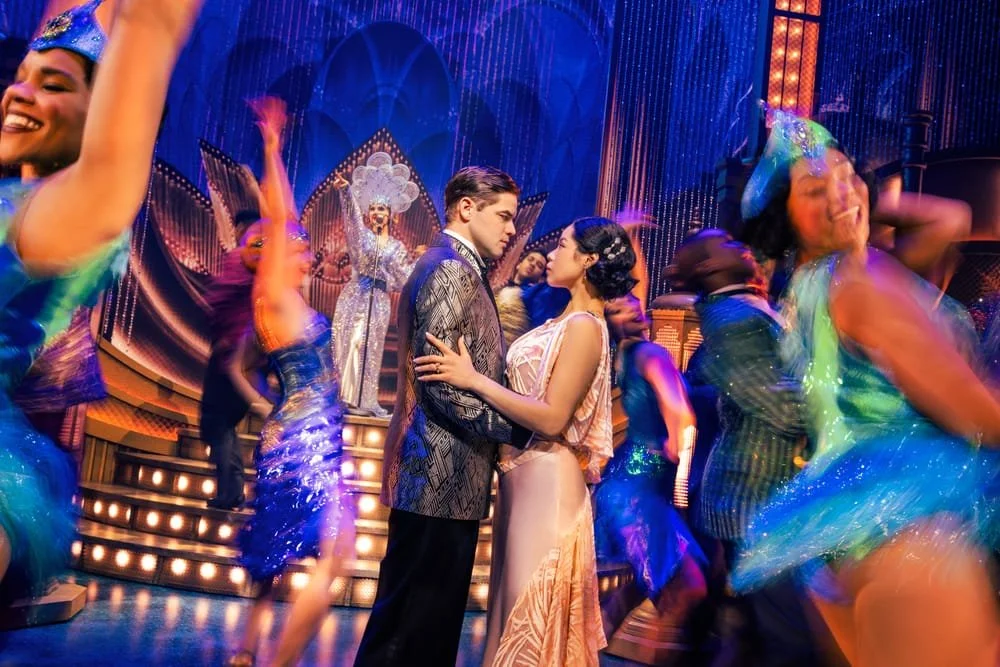The Great Gatsby
Jeremy Jordan and Eva Noblezada
April 30, 2024
The iconic image of the 2013 film The Great Gatsby, frequently featured in memes and GIFs, features Jay Gatsby raising a glass of champagne in a toast as fireworks explode behind him. Impeccably clad in a bespoke tuxedo, Gatsby’s smile is more of a smirk, and it reveals nothing about him. He’s toasting you, not himself, and you can project whatever you want onto him.
That film’s success or lack thereof can be debated elsewhere; that image captured Jay Gatsby’s essence – inscrutable, mysterious, a blank slate. That man is nowhere to be found at the Broadway Theater, where the new musical The Great Gatsby is in performances.
Gatsby’s entrance into the public domain invited adaptations galore, including last summer’s immersive production and another musical adaptation soon to premiere at the American Repertory Theater. That’s not to say this Gatsby is a bad musical. It’s a very successful production of a musical comedy. The songs are lively, the sets are lavish, the costumes are sparkling and the cast is extremely talented and attractive. But it is not a successful adaptation of F. Scott Fitzgerald’s novel. Far from it, old sport.
Instead, this Gatsby is a party, which is made clear from its first moments. As Nick (Noah J. Ricketts) introduces himself and the story to the audience, partygoers clad in sequins and sparkles crowd the stage, overshadowing him as they sing of the Roaring Twenties.
With a book by Kait Kerrigan, music by Jason Howland and lyrics by Nathan Tysen this adaptation of Gatsby leaves little to the imagination. Rather than keep the audience wondering who it is who throws the lavish parties and why he does it, everything is explained the moment Gatsby strolls onstage. It’s hard to reconcile the mysteriously absent party host with the man crooning, “I’ve done it all for her / Put up each wall for her / All the plans I laid / All the options weighed / Every price I paid for her … / Daisy.” Such a number is known as the “I Want” song in a musical. Jay Gatsby would never let anyone know what he wants.
Little else is left to the imagination, as blandly soaring ballads and generically jazzy songs proprell the show forward. Powerfully played by the 20-piece orchestra, they are capably entertaining but fail to capture the ethos of Fitzgerald’s novel. Marc Bruni’s direction emphasizes the surface glamour of the era, with no hint of the destruction lurking beneath the sparkle. Paul Tate dePoo III’s set design emphasizes the nouveau riche of Gatsby’s allure; both Gatsby’s yellow Rolls-Royce and Tom’s blue coupe are driven onstage, fireworks and fountains adorn the set while the actual buildings are merely projections. Linda Cho’s costumes are dazzling, worn by the outstanding ensemble performing Dominique Kelley’s show-stopping choreography, illuminated by Cory Pattak’s lighting. It is during those numbers that one can be swept away by the dazzle of this show. It’s also crucial to note that those songs don’t feature any of the principal characters.
Noah J. Ricketts, Samantha Pauly and ensemble
Again, it’s not for lack of effort. Jeremy Jordan’s Gatsby is endearing and appealing. His youthful face only enhances the open yearning his character feels for his lost love. His skittish nervousness while preparing for tea at Nick’s to surprise Daisy perfectly suits the character written on paper. It’s adorable, but hardly an accurate portrayal of the enigmatic millionaire.
Eva Noblezada’s Daisy is written as a more formidable character than in the book; Kerrigan has added conversations between Daisy and Jordan (Samantha Pauly), the self-proclaimed bachelorette, about women’s lack of freedom and options even in the new, post-war world. When Jordan questions Daisy’s choice to dress her infant daughter in swaths of lace, Daisy simply replies, “But there’s nothing to be done about that. It’s how babies dress.” She expresses similar complacency when confronted with her husband Tom’s (John Zdrojeski, appropriately smarmy) infidelity, seemingly considering it a fact of life rather than an injustice.
Tom’s mistress, Myrtle Wilson, is played by Sara Chase, who gives a valiant effort to make a written caricature into a flesh and blood person. The musical treats her with little sympathy, instead rendering her a brassy gold-digger, while presenting her husband George (Paul Whitty) as a good-hearted loyal husband.
Daisy’s acceptance puzzles both Jordan and Nick, who easily fall into a charming summer fling of their own. Pauly’s Jordan is breezily confident, can belt to the rafters and looks smashing in her wide-cut trousers. Ricketts’ Nick is presented as the show’s moral compass, outraged by Tom’s infidelity and shocked by the hedonistic alcohol, drugs and sex that surrounds him. He possesses enough naïveté to be properly devastated by Gatsby’s scandals while simultaneously personifying the classically handsome leading man. When he confronts Daisy, saying, “You and Tom smash up things and creatures, and then — you retreat back into your money or carelessness or whatever it is that keeps you two together,” his anger is authentic and justifies his decision to flee from the hedonistic wealth of New York.
Sadly, his disappointment hardly registers; this show offers almost none of Fitzgerald’s criticism of the greed and excess of the time. His portrayal of the Roaring Twenties was ironic, not celebratory. But as Nick speaks the novel’s famous final lines of “boats against the current,” his words are almost drowned out by the glittering ensemble from the beginning crowding the stage again. This cyclicality is hardly celebratory; despite the death and destruction wrought onstage, it’s clear no one has learned a thing.


